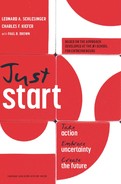Further Reading
From the dedication, you can see how important the research of Saras Sarasvathy has been to us. Her book, Effectuation: Elements of Entrepreneurial Experience, describes the thought and action processes of serial entrepreneurs. To learn more, visit www.effectuation.org, where she and her colleagues run an active Web site.
On first exposure, we found her ideas exciting and original and we wanted to explore them more deeply (desire). In February 2009, we created a course, Action Trumps Everything (www.actiontrumpseverything.com) and invited our friends and colleagues (got started with the means at hand). The only resources required were our time and a little money to rent the classroom (within our acceptable loss), and thus we were able to keep the tuition pretty low. Each session incorporated the feedback and experiences of the participants (entrepreneurs, aspiring entrepreneurs, social entrepreneurs, families, friends, supporters, bosses of entrepreneurs—ages sixteen to seventy-plus) (built off what we found) who participated in a process of codeveloping much of the framework you have read in the previous pages. These folks invited their friends and colleagues to the next sessions (they brought others along).
In the course of these seminars, we ended up discovering a number of additional ideas we added to our original notions. We made up the word Creaction in part to point to these additions and to distinguish it from Sarasvathy’s effectuation. In late 2010, we published Action Trumps Everything (Black Ink Press) based upon our learning from the course sessions and from additional explorations of multiple literatures, some of which are cited later.
The most significant of the outside ideas we added is the importance of desire as a complement and counterpoint to uncertainty. A source on this subject is William Irvine’s On Desire.
Closely linked to desire are the ideas of discovering and creating opportunities. There is an enormous amount written about these subjects. One good source on the creative process is The Path of Least Resistance by Robert Fritz. On an entirely different tack is Old Masters and Young Geniuses by David Galenson.
Enrollment is the third element not found in effectuation. Here we built off the pioneering work of Innovation Associates in organizational learning as described by Peter Senge in The Fifth Discipline and in many human potential workshops of the last forty years. Lewis Hyde’s, The Gift, carries great descriptions of the spirit behind enrollment.
In parallel with our efforts, the Babson faculty (Danna Greenberg, Kate McKone-Sweet, and H. James Wilson) has written The New Entrepreneurial Leader, which lays out a comprehensive framework for reinventing management education in order to help develop leaders who can and will shape social and economic opportunity.
Peter Sims has written a book we enjoyed, Little Bets, which covers some of the same subject matter we have addressed in this volume. His “Further Readings and Resources” chapter is a great source for further exploration.
The vast majority of the ideas presented in this book have withstood academic scrutiny and practical verification independently of each other—in some cases, over many decades—but so far, they have not been integrated in the fashion we have presented except in our courses. While there is no existing research history on the entire model, people with lifetimes of entrepreneurial experience have provided significant verification based upon their life experiences. In keeping with the book’s premise, we believe that’s good enough for now.
